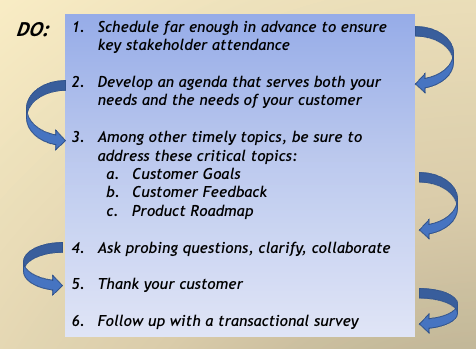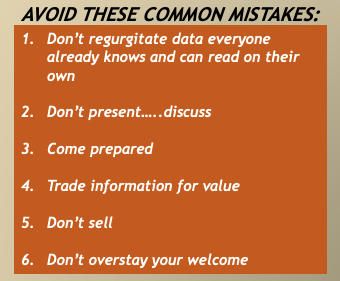Creating a Meaningful Business Review
Feb. 18, 2021 by David Ellin, Chief Customer Officer and Senior Consultant, Centric Leadership Strategies
You haven’t had time to prepare. You’re frantically pulling data, throwing together an agenda, and don’t even know who should attend.

Business Reviews (whether Quarterly or Executive) should be well-planned events with critical components for every meeting. Follow this plan and you’ll see immediate positive results.
Follow these steps

Schedule the date far enough in advance to ensure attendance from key stakeholders.
Collaborate on the best date, time, and meeting duration. If there’s travel involved, allow ample time for short delays.
Develop an agenda that serves your needs and those of your customer.
It’s all too common for CSMs to create an agenda in a vacuum that only addresses their talking points. Business Reviews are not for you…they’re for your customer. Collaborate on the agenda so your customer’s needs are addressed during the meeting. Remember, if your customer doesn’t see value in attending a Business Review, attendance will suffer as will the relationship.
Address these critical topics.
- Revisit customer goals. If you’re preparing annual Strategic Account Plans, those plans likely include your customer’s goals and objectives. Bring them up in every Business Review. Let your customer know what you’re doing to help them achieve their goals. Ask if there have been changes to their goals, if there are any new obstacles they’re facing, or if their priorities changed. If so, it’s likely you’ll need to shift your future actions.
- Customer Feedback. Don’t brush it under the rug – put it front-and-center. Let your customer know that you appreciate their feedback (via surveys, interviews, focus groups, etc.) and take action based on their comments. If you’re surveying many contacts within the customer’s business, display the aggregated results, talk about what’s good and what can be improved. Give examples of actions you’ve taken as a direct result of customer feedback.
- Product Roadmap. Take the opportunity to keep your customer informed of product enhancements. Give your customer a chance to weigh in on features that would bring value and items under consideration but not yet developed. You’ll gain valuable insights into what your customers want from your product.
- Ask probing questions, clarify, and collaborate.
- Probing questions create thought, engagement, and learning opportunities.
- “Can you tell me more about that?”
- “How do you feel this will impact your business?”
- “What obstacles are you facing in accomplishing that goal?”
- Clarifying what you heard shows interest, sincerity, and caring…”What I heard you say is…”
- Collaboration brings new ideas to the forefront and shows partnership…”What do you think about…?”
- Probing questions create thought, engagement, and learning opportunities.
- Thank your customer for attending and actively participating. Your customers are busy and they’re being pulled in many directions. Give a sincere ‘thank you’ for their attendance. Tell them how much you appreciate their time, input, and collaboration. At the end of the day, they may not remember what was discussed but they’ll certainly remember how you made them feel.
- Follow up with a summary and transactional survey. Send an email to thank the customer and summarize key points and action items. This reminds your customer of progress made and actions to be taken. Send a transactional survey. Transactional surveys are just one element of a Voice of the Customer program. The survey should thank them for attending and measure their satisfaction with meeting content, the value received, and the time invested. It should also ask for suggestions for improvement. Short…sweet…and highly valuable.

Avoid these common mistakes
- Don’t regurgitate data everyone already knows and can read on their own. Turn data into management information. Use data to develop and present insights, discuss trends, and create actions. “This chart illustrates the trend in…”; “What this tells us is…”; “If we do X, Y, and Z, we can positively change the trend…”.
- Don’t present…discuss. When you present, your customer sits back and likely drifts off to other topics. Keep your customer engaged in the meeting – maintain interest, drive interaction, and generate ideas that lead to action.
- Come prepared. Don’t just memorize the information to be discussed. Know what you’re talking about, understand the underlying issues, data, and causes. Know the contributing factors for successes and delays. Anticipate and be prepared to answer questions.
- Trade information for value. It’s easy to have a long list of topics to discuss during a Business Review. if there’s no value to be gained for your customer, the topic is simply a waste of time. Every topic discussed should add value. If it doesn’t, leave it out.
- Don’t sell. Business Reviews are about sharing insights and information, looking forward, being strategic, and making adjustments. They’re not about selling…not in an overt manner.
- Don’t overstay your welcome. You worked hard on preparation and you’ve got key stakeholders at the meeting. It’s easy to want to take advantage and keep going for hours. Don’t do it! Keep to an agreed-upon schedule and end on time. If you don’t, you’ll lose your audience and they’ll remember it. Future meeting attendance will suffer.
Quarterly Business Reviews (QBRs) and Executive Business Reviews (EBRs) are not the same. While being strategic, QBRs can contain some “in the weeds” conversations about critical projects and initiatives. EBRs should be highly strategic and avoid “deep dives” unless you’ve verified the need for that level of information in advance. EBRs should be shorter than QBRs as higher-level executives have less time to invest.
In Summary
Remember to gear your topics to your audience, include your customer in the planning process, deliver value, and show appreciation. Follow these steps and you’ll be on a great path toward successful Business Reviews.
Have questions or want more information? I can help. Feel free to reach out by clicking here.
